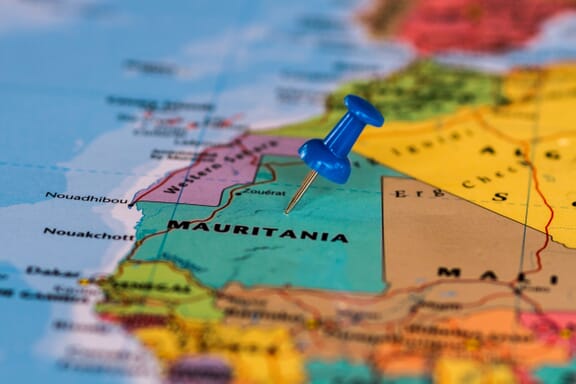Mauritania is located in the Northern Africa region at latitude 21.00789 and longitude -10.940835 and is part of the African continent.
The DMS coordinates for the center of the country are:
- 21° 0' 28.40'' N
- 10° 56' 27.01'' W
You can see the location of Mauritania on the world map below:

Mauritania Neighboring Countries
The neighboring countries of Mauritania (MR) are:
- Algeria (DZ)
- Mali (ML)
- Senegal (SN)
- Western Sahara (EH)
Maritime Borders
Mauritania borders the Atlantic Ocean.
Mauritania Related Content
Mauritania Key Facts
| Country | Mauritania |
| Coordinates | Latitude: 21.00789 Longitude: -10.940835 |
| Country Codes | Alpha 2: MR Alpha 3: MRT |
| Country Flag Emoji | 🇲🇷 |
| Int. Phone Prefix | +222 |
| Capital city | Nouakchott |
| Continent Subcontinent | Africa Northern Africa |
| Country Area | 1,030,700 sq km |
| Population 2021 | 4,775,110 World Rank: 125 |
| Median Age | 17.6 |
| Life expectancy | 64.4 |
| Major languages | Arabic (official and national), Pular, Soninke, Wolof (all national languages), French |
| UTC/GMT Time | Number of time zones: 1
|
| Internet TLD | .mr |
| Biggest Airport | Nouakchott–Oumtounsy International Airport (NKC) |
| Average temperature | 27.65 °C 81.77 °F |
| Administrative Divisions | 15 regions |
| Political system | Presidential representative democratic republic |
Mauritania Economy Facts
| World Bank Income Group | Lower middle income |
| World Bank Region | Sub-Saharan Africa |
| Currency | New Ouguiya (MRU) |
| GDP in 2020 | $7.9 (billions of USD) World Rank: 148 |
| GDP per capita in 2020 | $1,702 World Rank: 151 |
| Major Industries / Economic Sectors | Agriculture, manufacturing, energy, services |
| Top 5 Import Countries | China, United Arab Emirates, France, Senegal, India |
| Top 5 Export Countries | China, France, United Arab Emirates, India, Pakistan |
Biggest Cities in Mauritania
Here are the largest cities in Mauritania based on 2021 data:
| City | Population |
|---|
| Nouakchott | 1,077,169 | Nema | 200,000 | Nouadhibou | 118,000 | Kiffa | 110,714 | Zouerate | 56,345 | Rosso | 47,203 | Atar | 24,021 | Tidjikja | 19,981 | Boutilimit | 14,142 | Bogue | 10,415 |
Map of Mauritania with the Largest Cities
Other Countries in the Northern Africa Region
- Where is Algeria?
- Where is Benin?
- Where is Burkina Faso?
- Where is Cabo Verde?
- Where is Cameroon?
- Where is Chad?
- Where is Comoros?
- Where is Djibouti?
- Where is Egypt?
- Where is Equatorial Guinea?
- Where is Eritrea?
- Where is Ethiopia?
- Where is Gabon?
- Where is Gambia?
- Where is Ghana?
- Where is Guinea-Bissau?
- Where is Guinea?
- Where is Ivory Coast (Côte d’Ivoire)?
- Where is Liberia?
- Where is Libya?
- Where is Mali?
- Where is Morocco?
- Where is Niger?
- Where is Nigeria?
- Where is Sao Tome and Principe?
- Where is Senegal?
- Where is Sierra Leone?
- Where is Somalia?
- Where is Sudan?
- Where is the Central African Republic?
- Where is Togo?
- Where is Tunisia?